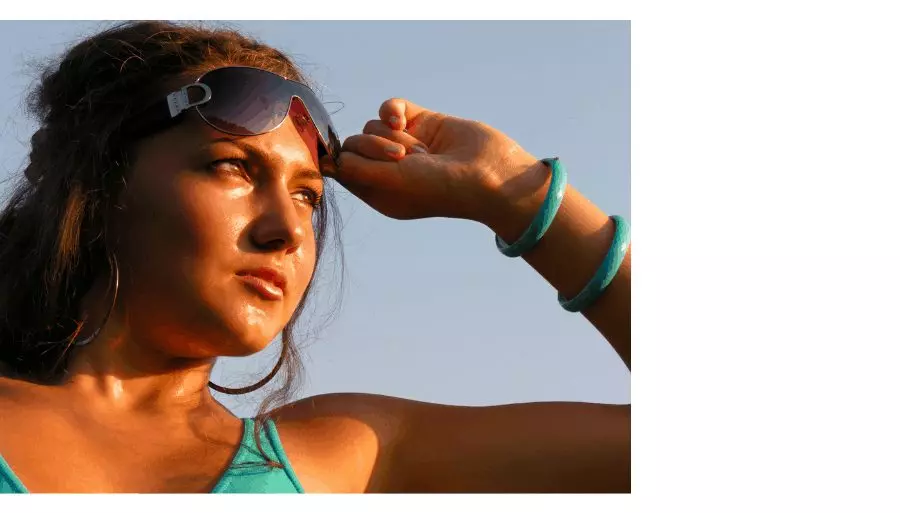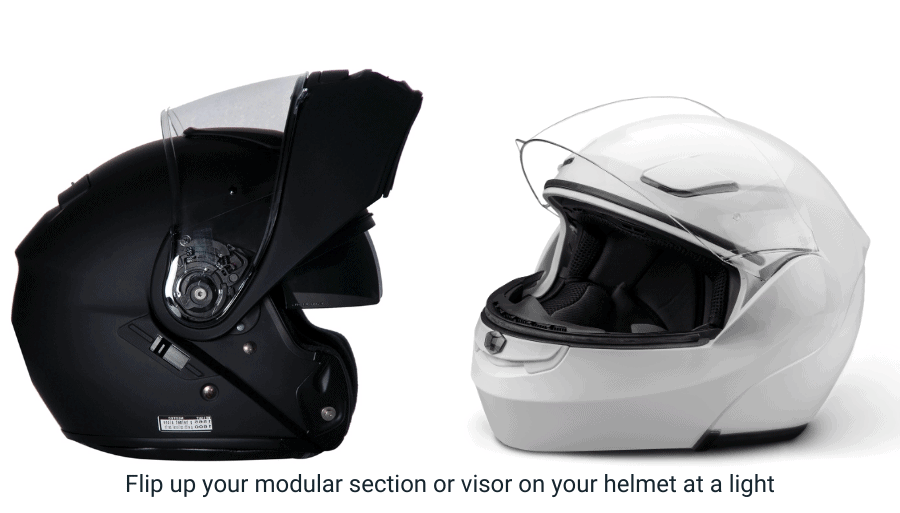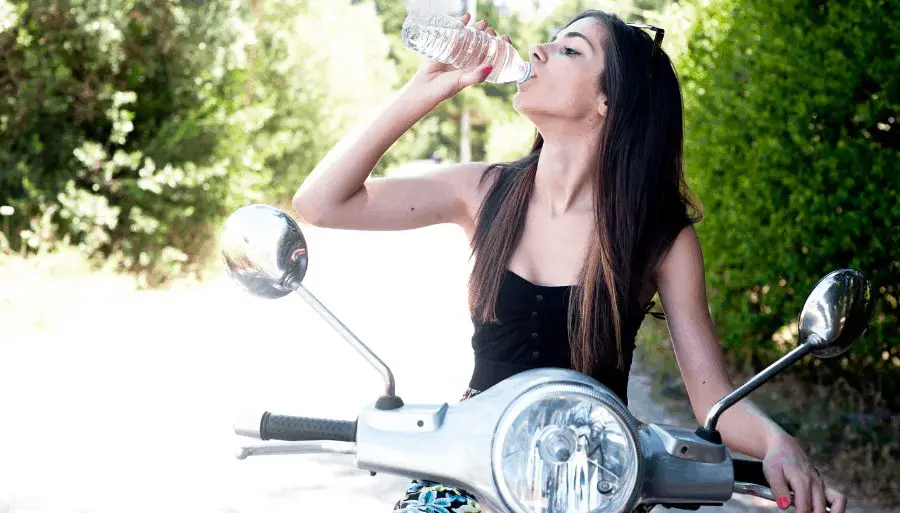The sky is beautiful, and you are out cruising on your scooter. You approach a traffic light. The longer you sit there, the more you realize that the brutal sun is beating down on you. You are wearing all of your safety riding gear. Now, you are wondering if this is the longest traffic light you have ever sat through as you begin thinking about what you can strip off just to survive the light. Will this light every change to green?! Have you had this moment? Do you wonder what you can do to make your scooter ride more comfortable in the heat?
To feel more comfortable when riding your scooter in the heat, wear gear that is moisture-wicking, has ventilation panels, and protective armor that will keep you safer in the event of an accident. Cooling towels can provide more immediate relief. In addition, riding a scooter in temperatures above 93 degrees causes you to sweat more even if you do not feel it, so staying hydrated is critical to keep your body able to regulate your temperature.
Heat Management 101
Do you remember learning that temperature is transferred from the warmer object to the cooler object? When you put a cube of ice into a drink, the ice melts from this. The temperature of the drink is hotter than the frozen ice, so it shares the heat and causes the ice to melt. Add in a higher surrounding air temperature and then wind, and the process happens even faster to the drink and ice. This goes back to that hotter air transferring its heat to the drink at a faster rate because of the warm air being circulated. This is the effect of you on your scooter. The wind transfers heat to your body faster as you are riding, so your temperature elevates.
Your body sweats to keep your temperature regulated when the air temperature is higher than your skin’s temperature. Think about it. You may not notice it, but you have certainly felt the exaggerated impact of your sweat’s cooling capability when you’re sweating and then you get a nice gust of wind. Bliss! This is amplified when you get the wind from going 45mph hitting you, but your body keeps trying to produce more and more sweat while the wind makes that sweat evaporation happen faster. Your body is fighting to stay within about 5 degrees of normal.
Black is known to absorb heat. Wearing white reflects it. This means wearing black can increase your sweat production with that heat absorption. Just remember that the more you sweat will lead to further dehydration as your body works to continually produce more sweat to continue the cycle. Think about staying hydrated regardless of when you are riding in temperatures beyond 93 degrees.

Gear to Keep You Cool
All The Gear, All The Time (ATGATT) is a safety philosophy that you should wear all of your gear for every ride. You never know when you are going to have an accident which is why they are called accidents. I know some riders do not go all-in when wearing gear, but for the gear you wear, you have options to make it more comfortable. Plus, gear actually reduces the amount of sweat you produce by blocking some heat. I am on the Texas gulf coast, and I certainly appreciate any heat reduction, I can find!
I am keeping specific gear recommendations here to a minimum, but I cover warm and cold weather gear in more detail in my recommendations if you need some help choosing in this department.
Helmet
If you are wearing a full-face helmet, they are designed with vents to help increase airflow when you need it. Before you start riding, just remember to open all of the vents. There is nothing worse than realizing you forgot mid-ride. Most are convenient enough to open while riding, but every time this happens to me I struggle to find 1 vent in particular. It is annoying.
Anytime you stop like at a traffic light, open up your visor. If you have a modular helmet, flip the bottom up. It is quick to flip both back down to carry on with your ride when the light changes.

Moisture-wicking fabric built into the liner of your helmet can be helpful to keep you more comfortable as you sweat. If your current helmet does not have this feature, you could benefit from just wearing a liner under your helmet like this one on Amazon.
Helmets that have this moisture-wicking feature tend to be designed overall for warm weather riding and have other nice options. Next time you need to shop for a helmet, amp up the cooling by opting for ones that have oversized vents to open and channels that improve overall air circulation. You will also find versions with a built-in sunshade that you will likely appreciate if you are out riding in the sweltering heat.
Base Layers
Layering the clothes you wear can be helpful to stay cool. At first glance, the benefit starts with being able to strip off the protective gear for relief when you are done riding. The right base layers can help wick sweat, too. Look for those synthetic options that promote moisture wicking to help keep you more comfortable when you do sweat. Cotton is the worst for riding in when it is hot outside. It just does not dry as fast.
There is gear on the market tailored for motorcycle riding, but even if you have some work-out gear already, you can just use it to help here. The gear marketed for motorcycle riding is moisture-wicking and antibacterial, but you will find these same features on most work-out gear more readily available.
Jacket, Pants, Gloves, Even Full Suits
There is specific summer gear available to cover your body fully and provide the protection you need on your elbows, back, knees, and other high impact points all while working to keep you cooler. Do not immediately think you need to shed the safety gear you wear as you will certainly appreciate if you ever find yourself in a jam. Ventilation options and special features stand out to help in this area, so here is a list of available features to look for if you are up for buying some gear to help solve for the heat.
Features to Look for: Most Ventilation
For the best ventilation, you will see gear with more ventilation panels made with mostly mesh fabric. This fabric is rated for motorcycle use and is designed at varying degrees to maintain its integrity in the event of an accident. There are many riders that prefer leather, but know as you dive into this that mesh will feel cooler than perforated leather. Speaking from the temperature perspective, at least.
- Mesh fabric for optimal airflow. Some even have venting in the CE rated armor points like in the shoulders and elbows.
- Ventilation panels incorporated. More panels = more ventilation.
- Leather with perforations instead of panels
- There are cooling vest options to incorporate, and some jackets will have inserts for a better fit with them.
- Interior liners made with moisture-wicking mesh.
- Some mesh jackets will have interior liners that can be zipped in or out. These liners may just be for warmth but some offer waterproofing protection, too.
- 3D mesh which is a honeycomb pattern that is said to allow more cooling air to circulate versus traditional mesh
- Thermoplastic Rubber (TPR) injected ventilated components which make them protective still yet lighter weight to allow for ventilation.
Features to Look for: Flexible Ventilation
Some options that work for summer riding can also offer some flexibility with features that make your gear able to provide comfort in more than just the hottest days of the summer. The temperature can vary widely when you are actively riding versus just hanging at a light, and protective gear that can go through multiple riding climates will provide more value in the long run.
- Velcro, snap, or zippered flaps or sections that can be opened for more venting or closed if it gets cooler.
- This applies to the flexible ventilation component, as well. Some mesh jackets will have interior liners that can be zipped in or out.
- Liners that can be removed for washing
Other Gear Solutions
You can also use items like cooling bandanas. You simply get them wet, squeeze the excess water out & place them around your neck or head or wipe your body down. There are neck gaiters if you are looking for a bigger option that can stay on well while you are riding.
You will not find much in the way of moisture-wicking, summer-specific footwear. I think the best option here would be boots with laces for a bit of ventilation, but I am not buying boots for summer, personally. For this reason, I just make a point to wear moisture-wicking athletic socks to help in this department. I will also pack a pair of shoes more appropriate for the heat when I get to my destination. Hello, flip flops!
More Cool-Me-Off Ideas
There are varying degrees of heat, and if you are just thinking you want to stay cool for a quick jaunt, the above does that for you. What about long rides? For those, you need to add in a bit more thought to stay safe and avoid heat exhaustion. Some ideas to keep you scooting safely.
Stay Hydrated
Drinking water is basic advice, but it is also fundamental to your health. If you are riding around sweating, you need to replenish the fluids to replace how much water you are losing. Make plenty of stops for water or add on a hydration pack such as a Camel-Bak for a steady supply without needing to stop.
Even more important, if you know you will be going on a long scooter ride, it is a good idea to limit drinking alcohol even the day before and definitely not while riding. Alcohol dehydrates you, and it is tough to add more water to stave off the effects of dehydration if you are dehydrated before you even start riding.
Caffeine can be drunk before hopping on your scooter before a ride but watch your consumption here. Caffeine can be dehydrating, too.

You can freeze a couple of water bottles the night before a long ride to help you have some cold water for your stops along your route.
Drink plenty of water leading up to your rides, and bring more with you than you think you will need to keep you hydrated by drinking every 15 minutes or so on a long ride.
Wear Your Gear
Whether you agree with the ATGATT gear philosophy or not, keeping your body covered provides some benefits beyond the impact kind. Wearing your gear prevents sunburn and dehydration. Essentially, your body produces sweat when it heats up. If you are not wearing gear, that sweat is evaporating very quickly. You will not necessarily feel this because the wind from the speed you are traveling makes it evaporate very quickly. In turn, your body produces more sweat. By limiting the heat that actually touches your skin and limiting some of the wind, you will preserve your sweat a bit longer. This should reduce the likelihood of dehydration.
Ride at Cooler Times of Day
If you get the choice, it is best to ride when the sun is not at its worst. I find it funny when I see times thrown out like 11-2 PM as being the worst for heat when in reality that is more like the time that the sun’s ultraviolet rays are at their worst.
The longer the sun is out, the more heat that collects. That means the hottest part of the day is around 3, and it does not get more bearable until around 5 PM in the dog days of summer. When I have the choice, I do try to steer clear of the 2-5 PM afternoon range. That said, most people get off work at 5 PM. It is what it is but hydrate some more beforehand if you have a long commute to deal with.
Wear Sunscreen
There are conflicting studies about whether sunscreen interferes with your sweat production and therefore temperature regulation or whether it aids because of the impact on the nitric oxide within your skin cells that are protected when using sunscreen. What we do know is that when you actually get a sunburn, your body does have a more difficult time regulating temperature. Where you are not wearing gear that protects your skin, you will want to make sure you have your sunscreen on. Think about areas like the back of your neck. Also, be sure to reapply your sunscreen if you are out riding for hours in a day.
Try Not to Overeat
If you eat a heavy meal, you fire that metabolism up which translates into a higher body temperature. I bet you feel that on a normal day. Think about how you feel after a big meal. Do you really want to do much? Your body just turns to focus internally on digestion. Have you gotten really stuffed and noticed a rise in the temperature?
Put Your Helmet in a Freezer
I have yet to try this, but I will definitely give it a try on my next long ride! Do you know those coolers filled with ice to sell outside of almost every convenience store? Put your helmet inside of one on your way in to get some cold water and stretch your legs. I can’t imagine that the stores want you to do this, but you could get lucky and find an empty one to make you feel less guilty. It would just be for a few moments, and I imagine it would be quite refreshing!
